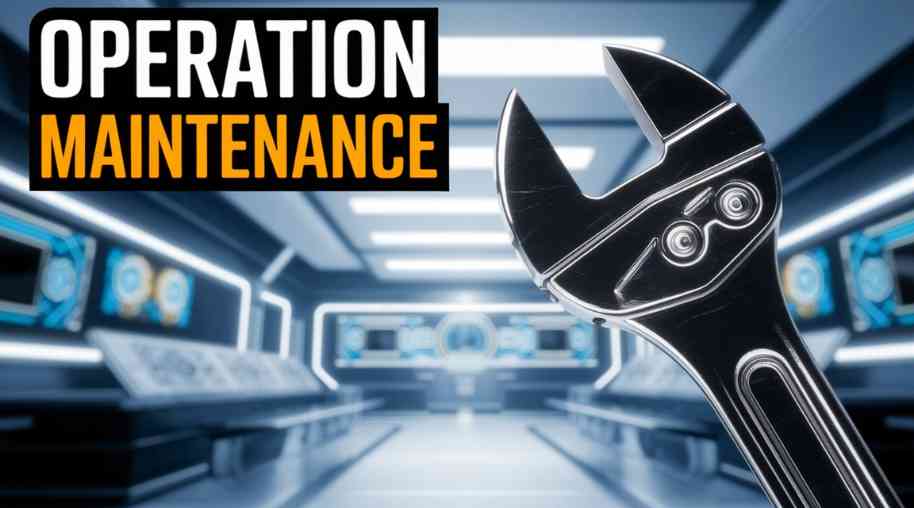O and M Full Form-Operation and Maintenance
by Shashi Gaherwar
0 2302
Operation and Maintenance: Ensuring Efficiency and Longevity of Assets
Operation and Maintenance (O&M) is critical for ensuring efficiency, safety, and cost-effectiveness across industries. Proper O&M practices prevent failures, reduce downtime, and extend asset life. This article explores O&M’s definition, importance, maintenance strategies, and best practices for operational efficiency.

What is Operation and Maintenance (O&M)?
Operation and Maintenance (O&M) encompasses activities to keep machinery, infrastructure, and systems functioning optimally. It includes inspections, repairs, upgrades, and preventive measures, vital for sectors like manufacturing, energy, transportation, and utilities.
Types of Maintenance Strategies in O&M
O&M employs various strategies:
- Preventive Maintenance (PM): Scheduled tasks (e.g., lubricating machinery, cleaning HVAC filters) reduce downtime and costs, extending lifespan.
- Predictive Maintenance (PdM): Uses data (e.g., vibration analysis, thermal imaging) to predict failures, minimizing breakdowns and costs.
- Corrective Maintenance (CM): Repairs post-failure (e.g., fixing motors) restore function but may increase costs if frequent.
- Condition-Based Maintenance (CBM): Acts on deterioration signs (e.g., monitoring temperature) to optimize resources and extend life.
- Reactive Maintenance (RM): Run-to-failure approach (e.g., fixing pipelines post-break) has low initial costs but high long-term expenses.
Importance of Effective O&M
O&M benefits include:
- Reliability: Reduces failures for consistent performance.
- Safety/Compliance: Ensures adherence to regulations, minimizing accidents.
- Efficiency: Lowers energy use and wastage.
- Cost Reduction: Prevents expensive emergency repairs.
- Asset Longevity: Extends equipment life, improving ROI.
Key Components of an Effective O&M Program
A robust O&M program includes:
- Planning/Scheduling: Routine inspections and servicing.
- Condition Monitoring: IoT sensors and analytics for asset health.
- Inventory Management: Ready spare parts availability.
- Workforce Training: Skilled staff for equipment handling.
- Data-Driven Decisions: CMMS for maintenance tracking.
Best Practices for Effective O&M Management
Best practices for O&M include:
- Proactive Approach: Prioritize preventive/predictive maintenance.
- Technology Use: Employ AI, IoT, and CMMS for efficiency.
- Standardized SOPs: Ensure consistent maintenance tasks.
- Employee Training: Update staff on technologies and safety.
- Regular Audits: Optimize schedules via assessments.
- Resource Optimization: Reduce energy use for sustainability.
Challenges in Operation and Maintenance
O&M challenges include:
- High Costs: Expensive systems and labor investments.
- Downtime: Maintenance disrupts operations.
- Complex Operations: Multi-location management needs coordination.
- Technology Integration: Compatibility and adaptation issues.
Case Study: Successful O&M Implementation
A manufacturing company cut equipment failures by 40% using a predictive maintenance program with IoT sensors. Monitoring vibration and temperature saved $500,000 annually in repair costs.
Effective Operation and Maintenance (O&M) strategies enhance efficiency, reduce costs, and prolong asset life. Proactive approaches, technology, and training drive reliability, safety, and financial success across industries.
Further Learning Resources
If you’re passionate about building a successful blogging website, check out this helpful guide at Coding Tag – How to Start a Successful Blog. It offers practical steps and expert tips to kickstart your blogging journey!
For dedicated UPSC exam preparation, we highly recommend visiting www.iasmania.com. It offers well-structured resources, current affairs, and subject-wise notes tailored specifically for aspirants. Start your journey today!

Share:








Comments
Waiting for your comments